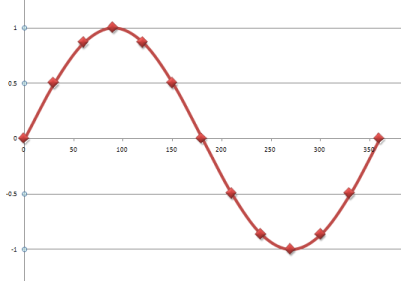Analog
 A
string tied to a doorknob is a practical example of an 'analog' system. The
string, when shaken, creates waves that travel down the length of the string
until they hit the doorknob. Shake the string harder and you get bigger waves
that travel faster down the string and hit the doorknob harder. Shake the string
more gently and you get smaller waves. Shake the string up and down and the
waves are oriented vertically, shake the string sideways and the waves are
oriented horizontally. One thing is constant--the shape created by the string
is wave-like.
A
string tied to a doorknob is a practical example of an 'analog' system. The
string, when shaken, creates waves that travel down the length of the string
until they hit the doorknob. Shake the string harder and you get bigger waves
that travel faster down the string and hit the doorknob harder. Shake the string
more gently and you get smaller waves. Shake the string up and down and the
waves are oriented vertically, shake the string sideways and the waves are
oriented horizontally. One thing is constant--the shape created by the string
is wave-like.
Analog systems are what I call wave systems. They have a value that changes steadily over time and can have any one of an infinite set of values in a range. Using our doorknob and string example, you can place a measuring stick at a specific point along the string and then measure the string's height from the floor every second at that point. When you watch the string move, you will see it moves constantly. It doesn't instantly jump up and down the ruler. Our string example is an analog system, it is not a digital system.
Analog signals are often described using the mathematical sine or cosine functions. When you graph the results of those functions, you get a curved line that looks something like the diagram on the right.
Digital
A digital system would be more like flipping a light switch on and off. Speaking in general terms, there is no 'in between' values, unlike our doorknob and string example above. If the switch you are using is not a dimmer switch, then the light is either on, or off. Our light-switch example uses the light bulb as our transmitter, the transmission media is the space between the lightbulb and your eyes, and the receiver of the signal is your eye.
This would be a digital system. A graph showing the properties of a digital transmission would look something like this:

Analog vs. Digital: A Comparison
Unfortunately, the science guys have to go and confuse things. They talk about digital systems having a 'square wave' appearance, and they are correct. The light doesn't instantly turn on, but it does happen so fast that we humans don't normally see the light actually in the process of 'lighting up'. We see it either lit, or unlit. When a signaling system changes that fast between specific values, its usually called a 'digital' system, especially when a computer is hooked up at either end.
Another example of a digital system would be the digital voice telephone system. The phone system uses something called Pulse Code Modulation (PCM). PCM uses 256 discrete voltage states to represent specific values or symbols. The phone system uses these discrete symbols to represent various values of sound on the phone line. Because there are only 256 symbols, the phone system can't reproduce the sound exactly, but it can sample the analog sound of the speaker's voice 8,000 times a second to create a 'close enough' approximation in digital format. Conversion from the analog to digital format is called quantization. Some of the sound of a human voice is lost, but enough is captured that another human being at the other end can recognize the voice and what is being said. The same thing occurs with digital photography. The camera can only record a limited number of colors, not the billions of colors our eyes can perceive. This is why digital photos sometimes look washed out, flat, off-color or with bands of colors compared to the real thing. This loss in conversion from analog to a digital format is referred to as digital noise.